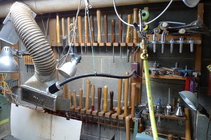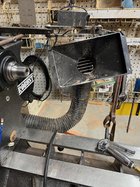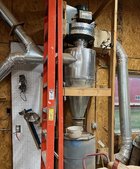Some time ago I put a hardware cloth cover over my dust collection hood to make sure nothing I wanted to keep was sucked into the dust collector. Even though the hardware cloth screen was of a large mesh curls kept getting caught and plugging up the screen. I took the hardware cover off and thought, I'll just be careful. Yesterday I wasn't. I was using a pet training pad to protect the ways on my lathe while I wet sanded a piece of walnut. I kept the dust collector on just to pull away some of the smell. Bad idea. The pet pad was pulled into the dust collector and immediately got wrapped in the fan before I could shut the unit down. I don't know if there's any damage but I have to take the Jet 2 HP dust collector apart and see. Some shredded pad was in the dust bag at the bottom of the filter but not all of it. Nothing in the pre-collection barrel. There is a question - if you put something over the dust port to keep out foreign items what do you use?
-
It's time to cast your vote in the October 2025 Turning Challenge. (click here for details) -
Congratulations to Curt Fuller for "Bell Ornaments" being selected as Turning of the Week for October 27, 2025 (click here for details) -
Welcome new registering member. Your username must be your real First and Last name (for example: John Doe). "Screen names" and "handles" are not allowed and your registration will be deleted if you don't use your real name. Also, do not use all caps nor all lower case.
You are using an out of date browser. It may not display this or other websites correctly.
You should upgrade or use an alternative browser.
You should upgrade or use an alternative browser.
Dust Hood Screen
- Thread starter Dave Fritz
- Start date
My HF DC has a guard over the fan inlet (where the hose attaches) that stops larger items like a rag from being sucked in. Some 1” x 1” square wire or chicken coup wire could be used to fab a guard.
Make your bed protector out of melamine shelf material with a wood strip on the bottom that will fit in the ways to hold it in place.
I have also made a half round shield with the opening facing back which will contain the lubricant (water in my case) somewhat.
I have also made a half round shield with the opening facing back which will contain the lubricant (water in my case) somewhat.
It's just my opinion, but I have to say I think it is a bad idea to use a dust collector or vacuum when working with flammable liquids. A little vapor may be ingested without problem, but imagine what happens with a lot of vapor, or if there is a spill.
I’m with Mark on this one.
Well, having a cyclone would prevent any strange things that get sucked up into the hoses from hitting the impellor blades. I got a light bulb once. Before I had a cyclone system, I had a 1 stage system. Sucked up a chunk of wood and it hit the blades. It took a bit of work, but I got the blades bent back into shape so the DC didn't walk all over the floor. The DC systems are NOT FOR FUMES! The spark from the motor could set them off. Set up a fan to blow the fumes away, and/or do it outside.
robo hippy
robo hippy
Tom Gall
TOTW Team
Is your hardware cloth easy to remove to shake off the curls? My version just lifts off - shake - replace. You could also turn off your DC to clean the curls but that would be PITA to me. See the previous discussion from November.Even though the hardware cloth screen was of a large mesh curls kept getting caught and plugging up the screen.

I initially started with the Big Gulp hood, but found it bulky. I now have the Mini Gulp (I think that is what it is called) and much easier to position. It has a built in grid. Much easier to place near the sanding. I converted my 3hp Jet twin DC to a cyclone. I bought the cyclone off Ebay from a guy in NY. It works as well as any name brand cyclone at a fraction of the price. I live in a rural area and vent outside, I do not have to clean any filters and the DC performance is always the same. I have been using this DC setup for over 5 years and no problems.




My hood has a grating and was bought that way. Just horizontal plastic. Doesn’t keep everything out but keeps the stuff you don't want to get sucked into the collector out. The hood comes with the Black Hole system from Craft Supplies USA.
- Joined
- Jul 18, 2018
- Messages
- 1,312
- Likes
- 2,811
- Location
- Baltimore, MD
- Website
- loujacobswoodturning.com
I only use my dust collector when sanding. When turning I’m not so worried about breathing dust. Maybe I’m being naïve, but the only time my handkerchief (read mucous) shows dust is when I’ve been sanding without the dust collector on. In addition, I use a PAPR which, while a bit cumbersome, offers complete protection.
Edited to add: I misspoke. I also have my tablesaw, bandsaw and jointer attached to the dust collector. In all cases nothing terribly course will get sucked through it.
Edited to add: I misspoke. I also have my tablesaw, bandsaw and jointer attached to the dust collector. In all cases nothing terribly course will get sucked through it.
Last edited:
Thank you all for the suggestions. Lots of good ideas and information as usual.
I have a 'homemade' dust hood for my lathe and do not have a cyclone that could prevent larger items entering the fan so I installed 1/2" hardware cloth where the 4" hose connects to the hood; easy solution for my set-up.
Tom Gall
TOTW Team
Henri, I assume your solution is similar to the photo of @William Rogers in #8 above. That is a very small surface area and will probably get clogged with curls (or other) in quick order. IMO, if you put the hardware cloth over the front of your hood there is a much larger surface area and will be easier to deal with. See my photo in post #7 above.I have a 'homemade' dust hood for my lathe and do not have a cyclone that could prevent larger items entering the fan so I installed 1/2" hardware cloth where the 4" hose connects to the hood; easy solution for my set-up.
Tom, I agree with your comment and I like your solution, thank you.
At this time my hood is a prototype cardboard box, about 12' x 12' x 12' that rests on top of the bench behind the lathe bed, a bit large and awkward; the chips and strings of wood simply drop at the bottom of the hood/box and do not reach the screen.
Based on this trial, I will build a sturdier hood/box and shape it to be more efficient at dust collection, not so much wood chip collection; based on final design I will consider moving the screen to the front of the hood.
At this time my hood is a prototype cardboard box, about 12' x 12' x 12' that rests on top of the bench behind the lathe bed, a bit large and awkward; the chips and strings of wood simply drop at the bottom of the hood/box and do not reach the screen.
Based on this trial, I will build a sturdier hood/box and shape it to be more efficient at dust collection, not so much wood chip collection; based on final design I will consider moving the screen to the front of the hood.
I dont use a hood. I tried a couple different types and found them bulky and difficult to position. I use a 4” 10 ft flex hose with slip on adapter (to fit other machines) and hose clamped a strong rare earth magnet to it. I can easily reposition to a good spot - HS, TS, bed rail, banjo.
Doug, did you see my post on how my setup on the Current best option for dust collection while power sanding thread? It really works well, and does not interfere with any lathe parts.I dont use a hood. I tried a couple different types and found them bulky and difficult to position. I use a 4” 10 ft flex hose with slip on adapter (to fit other machines) and hose clamped a strong rare earth magnet to it. I can easily reposition to a good spot - HS, TS, bed rail, banjo.
Tom Gall
TOTW Team
That may be true for green wood. If you turn dry wood (99% of my turning) there will be some dust along with the chips. I have the DC on whenever the lathe is on.@Tom Gall I don’t use it when “making chips”. I only use my DC whenr sanding. I don’t think any hood type system would be effective to catch chips when turning. This works just fine for sanding, never had a clog.
Don’t really disagree or agree, however I turn on my Jet air filtration system when turning. I feel it does a better job when turning dry wood than my hood. I just don’t think a hood does much good when turning (IMO). Plus I wear my PAPR (see avatar) turning dry wood. There is really no way to measure and it is just opinion.That may be true for green wood. If you turn dry wood (99% of my turning) there will be some dust along with the chips. I have the DC on whenever the lathe is on.
I don't know the "right" answer either, but I turn on (put on) all three when I turn dry wood.
The Black Hole (from Craft Supplies USA and other vendors), when connected to a dust collector (1 1/2 HP cyclone in my case), does a great job collecting most of the dust and even small shavings and chips when turning dry wood, which is mostly what I turn. I run it all the time when turning. I can actually see dust and small shavings get sucked into the hood. The horizontal grating in the hood keep anything too large from getting sucked into the dust collector. I wouldn't run the lathe without the dust collection system on. I also have an ceiling hung air cleaner, but I doubt that would handle the large amount of dust produced by turning dry wood and especially would not keep the dust from sanding out of the air. Just in case these 2 methods miss some of the finer dust I wear a powered air helmet with a HEPA filter. I guess I'm just careful.
